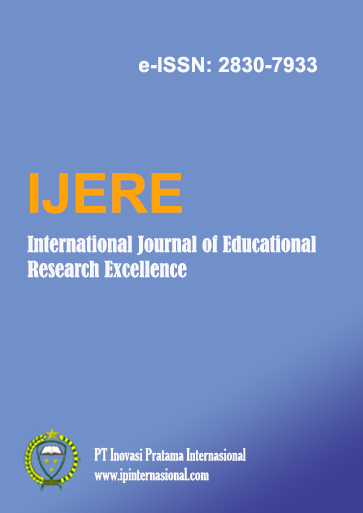MathAR Book Technology Innovation: Effectiveness of Using Augmented Reality-Based Mathematics Books on Students' Mathematical Understanding Ability
Main Article Content
Abstract
Educational innovation continues to develop with advances in digital technology, including the use of Augmented Reality (AR) in learning. This research aims to measure the effectiveness of AR-based mathematics books (MathAR Book) on students' mathematical understanding. MathAR Book integrates traditional learning content with AR elements such as 3D visualization and interactive animations to increase student interest and engagement in learning mathematics. This research methodology uses a quasi-experimental approach with a pretest-posttest design. The sample consisted of class XII students who were randomly selected and divided into an experimental group that used the MathAR Book and a control group that used conventional textbooks. The instruments used include tests of understanding mathematical concepts, learning motivation questionnaires, and in-depth interviews. The results showed a significant increase in students' mathematical understanding in the experimental group compared to the control group. MathAR Book students also showed increased learning motivation and concept visualization abilities. Student feedback indicates that AR creates a more engaging and effective learning environment. In conclusion, the MathAR Book effectively improves students' mathematical understanding.
Downloads
Article Details

This work is licensed under a Creative Commons Attribution 4.0 International License.
References
D. Bednorz, “Influence of primary students’ self-regulated learning profiles on their rating of a technology-enhanced learning environment for mathematics,” Front. Psychol., vol. 14, 2023, doi: 10.3389/fpsyg.2023.1074371.
U. Kossybayeva, B. Shaldykova, D. Akhmanova, and S. Kulanina, “Improving teaching in different disciplines of natural science and mathematics with innovative technologies,” Educ. Inf. Technol., vol. 27, no. 6, pp. 7869–7891, Dec. 2022, doi: 10.1007/s10639-022-10955-3.
A. Bahauddin, “Teacher’s and prospective-teacher’s perceptions of mobile math game ‘proadventure’ implementation in mathematics learning,” 2019. doi: 10.1088/1742-6596/1320/1/012080.
M. B. Nadzeri, M. Musa, C. C. Meng, and I. M. Ismail, “Teachers’ Perspectives on the Development of Augmented Reality Application in Geometry Topic for Elementary School,” Int. J. Interact. Mob. Technol., vol. 17, no. 15, pp. 38–52, 2023, doi: 10.3991/ijim.v17i15.40097.
Y. M. Arif, “Learning Material Selection for Metaverse-Based Mathematics Pedagogy Media Using Multi-Criteria Recommender System,” Int. J. Intell. Eng. Syst., vol. 15, no. 6, pp. 541–551, 2022, doi: 10.22266/ijies2022.1231.48.
S. Septinaningrum, K. A. Hakam, W. Setiawan, M. Agustin, W. Sopandi, and A. S. Surur, “Technology of Holobox Augmented Reality Grebeg Pancasila rite for Mathematics learning in Elementary School,” J. Phys. Conf. Ser., vol. 1869, no. 1, 2021, doi: 10.1088/1742-6596/1869/1/012119.
N. Imama, S. Utaminingsih, and A. H. Madjdi, “The Effectiveness of the Development of Problem Based Learning Model Based on Bakiak Game Technology in Mathematics Learning in Elementary Schools,” J. Phys. Conf. Ser., vol. 1823, no. 1, pp. 0–10, 2021, doi: 10.1088/1742-6596/1823/1/012079.
A. Fuentes-Cabrera, “Learning mathematics with emerging methodologies-The escape room as a case study,” Mathematics, vol. 8, no. 9, 2020, doi: 10.3390/math8091586.
H. Elmunsyah, “Interactive learning media innovation: Utilization of augmented reality and pop-up book to improve user’s learning autonomy,” 2019. doi: 10.1088/1742-6596/1193/1/012031.
S. A. Elsayed and H. I. Al-Najrani, “Effectiveness of the Augmented Reality on Improving the Visual Thinking in Mathematics and Academic Motivation for Middle School Students,” Eurasia J. Math. Sci. Technol. Educ., vol. 17, no. 8, pp. 1–16, 2021, doi: 10.29333/ejmste/11069.
J. Wong, “AUGMENTED REALITY FOR LEARNING MATHEMATICS: A PILOT STUDY WITH WEBXR AS AN ACCESSIBLE TOOL,” 2022. doi: 10.5821/conference-9788412322262.1216.
M. Abu-Arqoub, “Interactive multimedia-based educational system for children using interactive book with augmented reality,” J. Comput. Sci., vol. 15, no. 11, pp. 1648–1658, 2019, doi: 10.3844/jcssp.2019.1648-1658.
S. Poçan, B. Altay, and C. Yaşaroğlu, “The Effects of Mobile Technology on Learning Performance and Motivation in Mathematics Education,” Educ. Inf. Technol., vol. 28, no. 1, pp. 683–712, Dec. 2022, doi: 10.1007/s10639-022-11166-6.
Anisah, “Augmented reality water rocket: Develop an enrichment book of physics,” 2019. doi: 10.1088/1742-6596/1185/1/012044.
M. Rojas-Contreras, “Measurement of emotional variables through a brain-computer interface in the interaction with books with augmented reality in higher education,” 2020. doi: 10.1088/1742-6596/1674/1/012016.
A. Ntagiantas, “An Augmented Reality Children’s Book Edutainment through Participatory Content Creation and Promotion Based on the Pastoral Life of Psiloritis,” Appl. Sci., vol. 12, no. 3, 2022, doi: 10.3390/app12031339.
R. Wang, “Application of Augmented Reality Technology in Children’s Picture Books Based on Educational Psychology,” Front. Psychol., vol. 13, 2022, doi: 10.3389/fpsyg.2022.782958.
S. Setiyani, “Implementation of comic on linear program material to increase mathematical understanding for students of XI grade senior high school,” 2019. doi: 10.1088/1742-6596/1157/3/032083.

